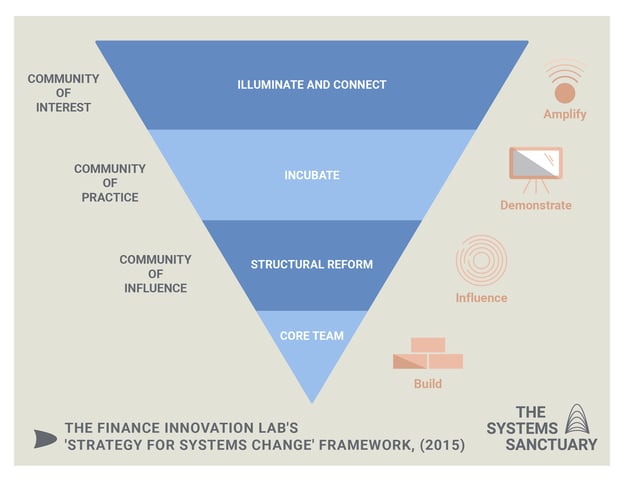In our Masterclass on Systems Practice, we always begin our sessions sharing our capacities framework. This helps participants to locate where they are on the journey, and to self-assess where they are strong and skilled up in their practices, or where they may want to gather more and deepen.
Our systems leadership capabilities framework
What is your lineage?
We then ask participants to reflect on, what is your way into systems change? What lineage, what practices, what stories bring you here? We do this because systems practice draws on many roots. While the emerging field is born from a Western science and academic world; lingers with the spiritual, psychological and cultural spaces. People come to systems change with their own lenses, frameworks, tricks and histories. It's important that we honour these and then connect the dots.
Seeing the system
One of our core capacities we like to dive into is ‘seeing the system’. We love to geek out on the many different ways we can use mapping tools to help us in different stages of systems change collaborations. These tools are very practical and useful, and they demystify what can often feel like highly technical and inaccessible tools and processes.
As we prep for our upcoming masterclass sessions, we saw a pattern emerging in how we use these tools. Maps are useful for different stages of an ecosystem initiative. Here is what we are noticing:
1) Early analyses of the problem: Iceberg, Forces and Actor Maps
We like to use mapping tools like the iceberg model, causal loop, forces mapping and actor mapping in the early stages of an initiative, before strategy development. These maps are best applied to help a group collectively grapple with the systemic and cultural levels of a systems challenge.
They help groups in moments of divergence and allow multiplicity and complexity to live in the strategy work. It's critical to have communities centred that experience the impacts of the system you are working in, and to have diverse systems actors in the room contributing to the process. The mapping work is messy and you definitely won't take the map home for framing, it's more about the process than the outcome.
2) Overall Systems Change Strategy Development: Transition Theory and Ecosystems Mapping
Use these tools when you have an ecosystem that has been working together for some time; when there is a shared understanding of the problem and when you want to begin to see what interventions exist in the systems, where are the gaps, what may be duplicating and what can we do together that we can’t do alone. In other words, you are rolling up your sleeves and getting strategic, you are identifying acupuncture points, connecting existing initiatives, and taking your work to the next level.
These maps can be used as baseline data, in evaluations and to guide strategic learning. They can be adapted as strategies emerge and evolve, they help collaboratives to analyze the emerging dynamics in a systems and to make decisions about how to adapt and respond; where there may be alignment and momentum, and to see the interaction between landscape influences and deep roots systems thereby informing ways to inject new narratives and influence.
We use a simplified version of Transition Theory By Geels (2011) with an additional layer, the "Deep Roots System"
added as a result of research by Tatiana Fraser and Juniper Glass (2020)
3) Ecosystem self-awareness and design:
We recently started to use this map in our strategy intensives and with initiatives that are a few years in or at a stage where their ecosystem has multiple collective initiatives working across different levels. We love this model because it aligns with our feminist and relational approaches to this work. It draws on Meg Wheatley's work and theory about how communities of practice emerge into communities of influence and that this is where the systemic and structural work happens. 
It helps teams to make sense of the often overwhelming and very messy nature of their work, to simplify the complex, to make decisions about what can be let go of and where to make the next move to take the work to the next level. It also helps teams to structure partnerships and to think strategically about how resources are being deployed, decentralized and effectively used to have an impact.
Want to Learn More?
If you want to learn more, join us for one of our Fall programs for systems practitioners:
Masterclass in systems practice
- Small Cohorts,
- 7 months
- international group
- Basic theory through to key frameworks & mapping tools.
- For Systems Leaders 2 years into their work
- Dive directly into practice with others who get it
- Small cohorts
- 7 months.
Build your own peer learning program
- How to create excellent virtual peer learning programs for systems change
- Step by step training - from our 4 years of experience.
We also offer Strategy Intensives for people running ecosystem projects, who are amid a major strategic pivot and need some fast and effective help to get unstuck and move forward.
Get in touch with us
This article was co-authored by Tatiana Fraser and Rachel Sinha.




